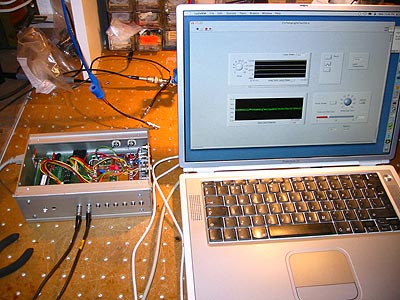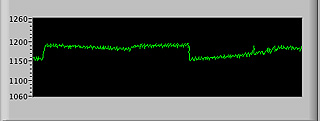
Return to home page

I have made a computerized remote control for the whole holographic setup, incl laser tuning via etalon temperature and live monitoring of mode jumps. Its main purpose is of course to automatically control shutter and settling times without the need of intervention. Another purpose is to control and supervise the whole machinery from an adjacent room, so that one does not need to be present in the holographic room anytime soon before the shot. In this way vibrations, air currents from opening doors, temperature gradients and so on can be minimized. I found this a greater factor on the quality/success of a hologram than I had anticipated; in fact, I did not have any failure in generating holograms (apart from lighting and chemistry issues), since I use the remote control.
The remote control uses the IOWarrior chip which serves as IIC bus master for a MAX1238 ADC, MAX 5822 DAC and a MAX6626 temperature sensor (those chips can be obtained for free at Maxim) On the other side, the IOWarrior provides an interface to the USB port of a Mac running MacOSX; this would work also under that other Unix OS, and gasp, W$. On the software side, I wrote a C-program which forms the computer interface node ("CIN") between the IOWarrior interface and a LabVIEW "virtual instrument" which then provides an easy-to-create graphical user interface.
A zipped archive of the software is here. The CIN can be compiled as-is under MacOSX, see the LabVIEW instructions how to do this, and it needs to be adapted for compilation under other OS. For more LabVIEW programs and CINs to interface with the IOWarrior chip see also the pages on my Coherent315 controller project.

The upper display shows long-term variations of laser power, and the middle one shows the etalon temperature. The lower display samples the laser output power in real time at ca 20 measurements/sec. When the laser is not disturbed, the output power stays constant over long periods of time, and only minor power fluctuations are visible despite I do not use light feedback to the power supply.

The variations on the displays stem from changing the etalon temperature. You see how the temperature regulator swings a bit before it settles back to equilibrium (the displays show a 20 minute time span). While it is not in equilibrium, one can observe mode jumps on the fast real-time display (20 sec time span):

This makes it easy to check when the laser has thermally stabilized and when it is a good time for making holography shots without mode jumps. Once settled, which takes an hour or more, such mode jumps are in fact quite rare, say one within a few minutes.
Return to home page